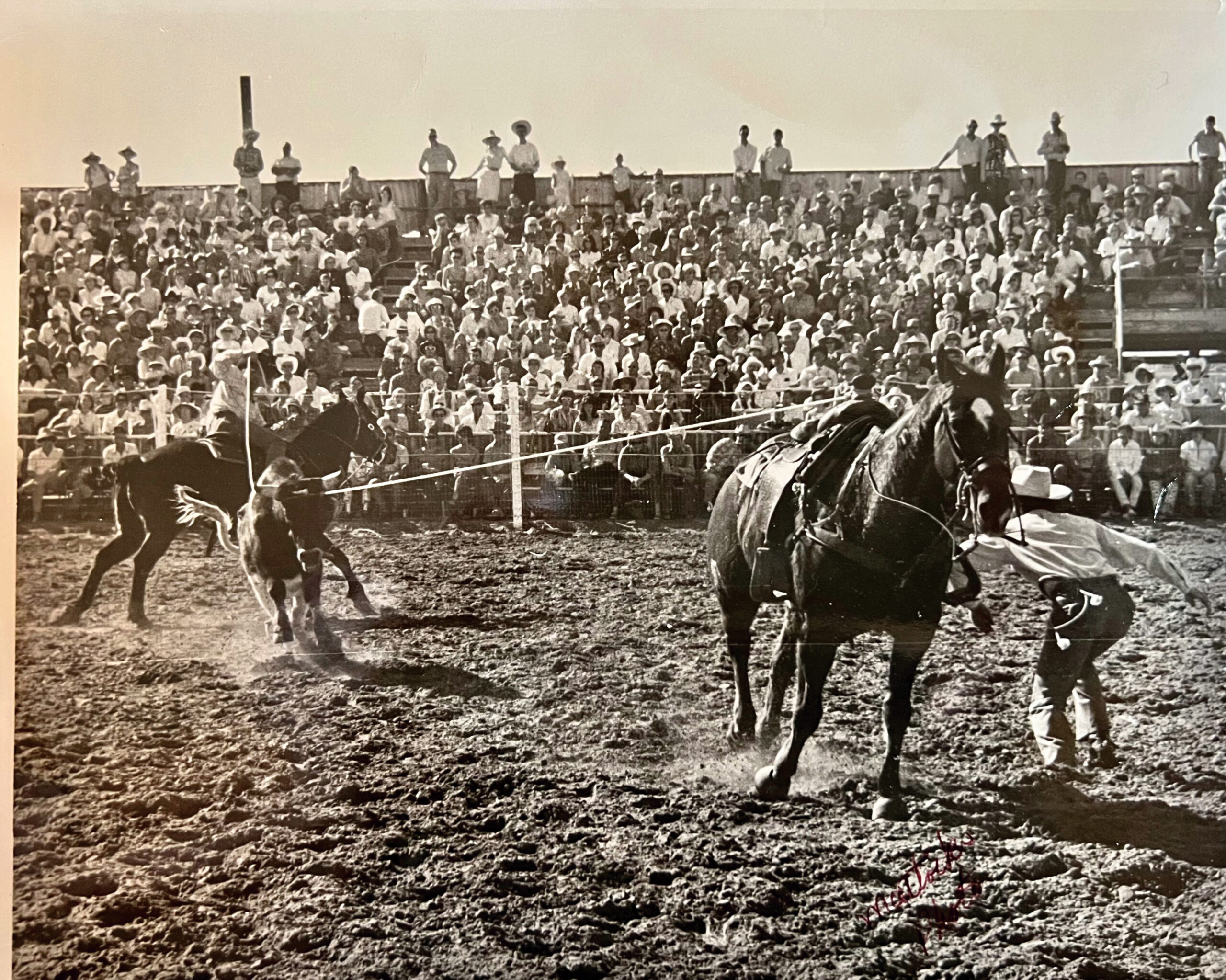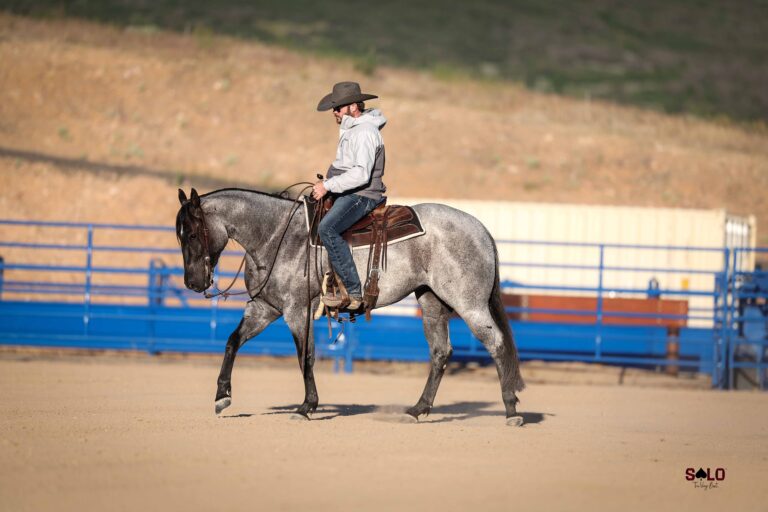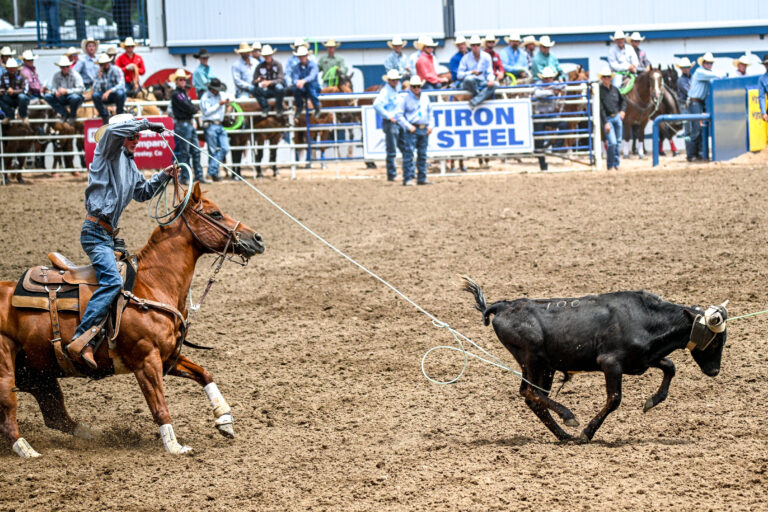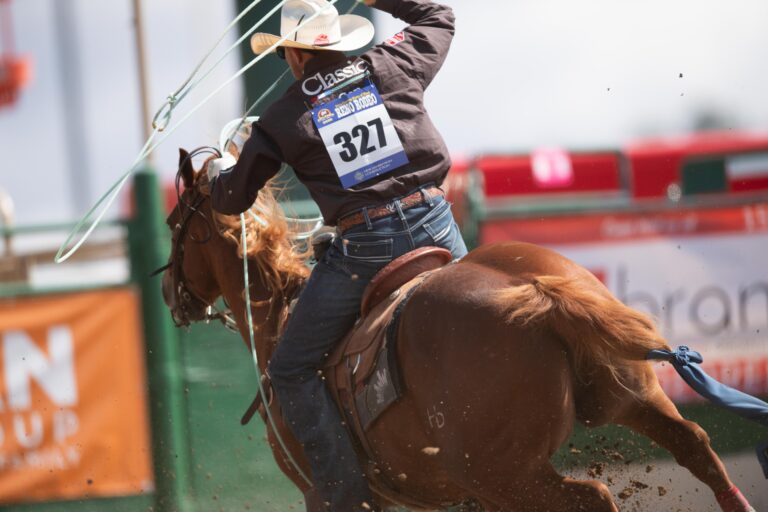Practically no one under 70 has seen it.
It’s not on Wikipedia.
Google’s never heard of it.
But team roping was team tying in most of the country from the 1930s through the 1972 NFR.
Like rodeo’s current events of steer and tie-down roping, it evolved from ranch work—tying cattle down to doctor, castrate or brand. And even though team ropers have dallied now for 50 years, team tying is still relevant—it was added a few years ago to the roster at the prestigious Windy Ryon Memorial.
This May in Saginaw, Texas, NFR heeler Ross Ashford and steer roper Laramie Allen won the Knot Tying two-header, 40-percenting the field of just eight teams to earn around $1,500 a man and trophy buckles and coolers. The duo, just 23 and 22, fell into the invitation that belonged to Tory Morrison and Dakota Kirchenschlager, neither of whom could attend this year. Only eight teams are annually invited.
“It’s old-school and we don’t get a chance to do that very often,” said Ashford. “It was a lot of fun. I’d always wanted to do it, and it helped that Laramie had a tripping horse we could use.”
What Is Team Tying?
Curious yet? Here’s a team tying run, in which both ropes are tied on: You rope the bones of a steer weighing 675 pounds and, as your horse starts its move, you slide your right leg over your saddle before the rope gets too tight over your cantle. As your heeler makes the corner, you’re hanging in your left stirrup watching, ready to step off as he delivers.
Your heeler catches two feet and holds his slack up, wheeling his horse around to step 180 degrees the other way. That’s to stretch the ropes enough to lay the steer on the ground (the only way to get a qualified time). You’ve stepped off by now and your head horse has logged to the end of the rope, leaning into it and holding it tight like a steer horse. If everything works out, the steer falls right as you meet it, with legs facing you. You whip a six-foot string out of your belt, tie the two hind legs together with a square knot and throw your hands in the air.
The glory in that era went to headers, not heelers. But the latter were the actual quarterbacks. If your heeler only caught one leg, he had to build enough tension to get the steer on its side by creating a “V” with the head and heel ropes before the stretch. So he rode his horse hard to the left, then straight away, making the ropes come tight with the kind of sick torque that could—and often did—snap a rope in two.
NFR heavyweight headers John Miller and Reg Camarillo liken a flawless team tying run to the subtle finesse of the branding corral; of hands who can make roping and dragging calves to the fire an actual art just by knowing how to time their throws and log their horses off at the perfect angle.
“Heelers got where they could turn that steer over once and roll him right up to you, and you’d just tie him,” said Miller, the two-time world champ. “A lot of times you’d get him tied before he quit rolling. It was an athletic event. And if you had good horses, good cattle and good cowboys, it was a really pretty event to watch. You didn’t cripple any cattle if the ropers knew what they were doing and the horses worked well.”

Rough and Ready
Here’s the part that attracted NASCAR-type fans: if the approaching header wasn’t in the optimal location as that V pinged straight, he could get clotheslined with a ton of force. Getting “caught in the V” meant getting mucked out either by the head rope—which snapped many a header’s leg—or the rolling steer.
“That V could come and get you sometimes,” said Dick Yates, 85, who later had to learn to dally rope before making 13 NFRs with his son, J.D. “I was practicing to go to Tucson once in the ’70s and I got caught in the V and it broke my ankle.”
Agility has never been quite the same in the world’s best headers.
“The scariest thing I ever saw was one time at Yuma, Arizona,” said 14-time NFR heeler Ace Berry, a native Californian who dallied before he ever learned to lay steers down. “A saddle horn got torn out of the header’s saddle and boy, that thing came back like a slingshot and if it would have hit him, it probably would have killed him.”
The best horses were a bit different then. You wanted a head horse that wouldn’t let the crowd spook him once you stepped off. You wanted a heel horse that was stout enough to hold up his end.
“I was at a jackpot in Prescott one time, a two-steer average roping with Tiny Bradford, who was a left-handed heeler,” recalled Miller, now 79. “Tiny’s horse got jerked straight over backwards both times. I had the steer tied and he stayed on his horse, so we got the flag.”
Tying Versus Dallying
Arizona and New Mexico were ground zero for team tying, and it spread from there to west Texas and north into Colorado, Wyoming and Montana. The PRCA still wouldn’t include it at virtually any rodeos, so it happened at jackpots and amateur rodeos until the 1960s. Meanwhile, Californians only dally roped. When eventual four-time NFR average champ Reg Camarillo was still in the Army stationed near Colorado Springs, he spent weekends in Pueblo with the Yates family, where he was exposed to tying.
In fact, at the first NFR team roping in ’59 in Clayton, New Mexico, they decided to dally every other steer of the 10 rounds to even the playing field for the west-coasters. Turned out both factions had something new to learn.
“One time, Jerold’s dad sold a horse to Tex Earnhardt, the auto dealer in Queen Creek, Arizona, for his son, Hal,” recalled Camarillo, a California cousin to Hall-of-Famers Jerold and Leo. “We were just kids; I think Jerold was still in high school. Tex took us to Roy Wales’ place where a bunch of big names were practicing tying. He wanted us to do a little demo. They had no rubber on their horns. I headed this steer and Jerold two-footed him and dallied and smoke came off his horn. Those guys grilled us on how we did that, and shortly after that they started dallying.”
Meanwhile, Miller was going to college at Cal Poly in the early ’60s.
“In tying, the Arizona guys kicked the Californians’ butts until we got it figured out,” he recalled. “I shortened up my rope a lot and put my heelers on my good horses. We got where we were winning, so the first time anybody ever got barred from a team roping was us, at a big jackpot in Phoenix where they were tying in ’65 or 66.”
It paid to have a horse like Miller’s, on which you could tie or dally.
“He’d log like a tripping horse, or all I had to do was ask him to face and he’d snap around,” Miller said.
On the heel side, one would think wheeling horses left would make them anticipate a bit. Maybe quarter?
“Well, every horse is different, just like now,” said Reg. “Some horses are cheaters and some are pretty honest.”
He had one head horse that Leo loved to heel behind, so when team tying was put to rest in the 1970s, Reg sold him to Tee Woolman at Leo’s request. Woolman later sold him to a tripper, and the horse was ridden at a later NFSR.
Who Were the Best Team Tyers?
The 1960 stand-alone NFR team roping in Scottsdale, Arizona, was also five rounds tying and five dallying. But the ’61 Finals went to Santa Maria, California. There, and in Los Angeles when it was integrated with the actual NFR, they dallied all 10. Once the Finals went to Oklahoma City in ’65, it went back to five rounds of each. Reg and the late Leo Camarillo won three straight NFRs, ’69 through ’71.
“One of those years, we were behind in the 10th round, which was tying,” recalled Reg, now 77. “We had to be 18 to win second in the average or go for it and be under 11, and we drew a Brahman cross that had taken everybody out because he ran behind the head horse. I told Leo, ‘Let’s go for it.’ When I turned him, he sure enough leaped behind my horse, but Leo nailed him and dropped him right at my feet and we were 10.6. We got a standing ovation. That was fun.”
Clocking a 10 or 11 then was the same as a 5- or 6-second run today. A few times, champs like Miller and Camarillo threw their hands up in 8.5, which was like today’s 3.7.
The final NFR go-round that featured tying was in 1972. On that steer in Oklahoma City, Miller and Ace Berry had to be 10.8 to win the average. They went 10.3 on a 700-pounder and set an arena record. Berry had also won the average back in ’67 with Bradford.

The elite heelers knew how to drop steers in their header’s laps. Few guys were as good at it, though, as Arizona Hall-of-Famer Joe Glenn, who had a magic partner in the catty little Arizonan, Art Arnold.
“I heard as a kid they could roll a steer over the top of Art, and he’d have him tied when they hit the ground on the other side,” recalled rope-horse trainer and Arizona native Clay Logan, who’s won the team tying at both the Windy Ryon and Spicer Gripp in the past 10 years. “‘No way!’ I thought at the time. But then I went to a Cowpunchers rodeo one year and watched him do it—in his mid-50s! I’ll never forget it. He should be in the ProRodeo Hall of Fame. He was the best, ever.”
Arnold was to team tying what Guy Allen was to steer roping; Cody Ohl to calf roping. Mel Potter can recall him winning eight rodeos in a row. In fact, Arnold won every big rodeo from Prescott to Phoenix, and roped at 11 total NFRs, winning the ’68 gold buckle. He was no slouch at dallying, either, having won Salinas with Glenn and the Chowchilla 8 Steer average with Dale Smith before it turned into the BFI. But oh, his lightning-fast tie.
One heeler, after the first steer he ever roped with Arnold, said he heeled and wheeled and then looked back to see how his partner was doing—and Arnold was already walking back to his head horse. Bulldogging GOAT Harley May was once asked by a novice flagger how to flag the team tying. He told him, and the flagger said, “That sounds simple enough.” And May replied, “Except for one thing—when Art Arnold slides into one, just drop it. Because otherwise you’re late.”
Arnold, now 82 and still living near Buckeye, Arizona, admits he spent a lot of time perfecting his tie. But he credits his partners.
“There was an art to what the heelers could do, and I don’t really know how they did it,” he said. “Joe Glenn was probably the best. I could judge where the steer was going to stop within about one inch every time. He usually rode one jump left and then straight back. How he landed them the same every time was beyond me. He was as good as Leo in team tying.”

Cowboy Finesse
The mixture of novelty and pure cowboy athleticism means team tying still happens in select arenas. Heck, it’s how Laramie Allen and his dad train their steer roping horses.
“People for years would come by the house in Pueblo and had never seen tie-down team roping,” said Yates. “So we’d tie a steer or two down to show them. J.D.’s done it.”

The Sioux County Fair and Rodeo in Harrison, Nebraska, has never stopped including it on their day sheet. And the Arizona Cowpuncher’s Reunion Association (ACRA) has been hosting it at two rodeos a year since 1978, while Ty Yost’s Rancho Rio in Wickenburg features it on occasion. In Texas, it’s now happening in Saginaw thanks to a throwback cowboy named Steve Tucker who used to tie for a then-teenaged Mark Spillman.
“I was fascinated watching him clap his hands and tie that square knot,” said Spillman, a Windy Ryon committeeman.
“It would scare you how fast he could tie.”
In 2018, Spillman helped bring team tying to the Windy Ryon, which has been held since 1973.
Why the Team Tying Tradition Continues
“It’s a way of keeping the history alive,” he said. “It’s the way team roping started in the professional ranks. Reg and Leo were dallying, but the rest of the country were hard-and-fast guys.”
Like steer roping, the event hovers under the radar because it can be hard on cattle. But contestants couldn’t take it more seriously. In fact, it’s the premier event in the ACRA that everyone wants to enter and win.
“It’s such a cool event,” said association secretary Carrie Gross. “Everything has to come together perfectly, which is the team aspect of it. It’s that old-time stuff you don’t see anymore.”
The prestige that comes with it is born of dirty-tough, superbly trained horses, extra masterful cowboys and perfect teamwork. That’s why Spillman is excited to enhance the Windy Ryon Knot Tying even further in 2023—and why Ashford and Allen are angling for a permanent invite.











